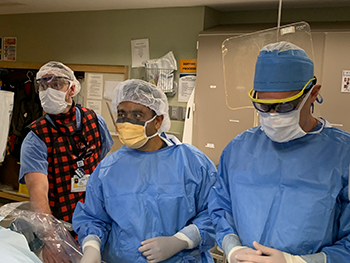About the Program
We are a medium-sized city in Upstate New York, located between Buffalo and Syracuse, along the shores of Lake Ontario. We serve Western New York from Syracuse to Buffalo, down to Northern Pennsylvania. The University of Rochester Medical Center, with over 880 beds, with the free-standing Golisano Children’s Hospital and the Wilmot Cancer Center, offers training programs in virtually all specialties. It is also the largest employer in Rochester, New York.
Applications for the Interventional Radiology-Integrated Program are accepted through ERAS.
Mission Statement
The Integrated Interventional Radiology Residency Program at the University of Rochester seeks to be the preferred Western New York entity for patients, providers, and trainees in interventional radiology patient care and education.
Program Aims
The program is dedicated to achieving its mission through a focus on four key pillars: patient care, education, research, and inclusivity. We are committed to:
- Delivering exceptional patient care in a patient-centered environment that respects each patient's values, beliefs, and needs.
- Providing a rigorous and immersive learning experience for our trainees within a nurturing environment that encourages critical thinking and fosters collegiality.
- Creating and maintaining a robust research environment aimed at improving safety and patient outcomes.
- Ensuring diversity in thoughts, processes, and individuals is not just encouraged but insisted upon.
 Training Experience and Strengths of Our Program
Training Experience and Strengths of Our Program
The University of Rochester offers an advanced ACGME-accredited five-year residency in interventional radiology. The program spans Post Graduate Years (PGY) 2 through 6. Successful completion of an ACGME-approved clinical PGY-1 year is required before beginning the residency, with a preliminary year in surgery highly recommended.
The Integrated Interventional Radiology Residency provides comprehensive experience in general diagnostic radiology, including subspecialties such as pulmonary, abdominal, emergency, neurological, musculoskeletal, and pediatric radiology. The program emphasizes skilled interpretation of magnetic resonance imaging, computed tomography, ultrasonography, nuclear medicine, and computed radiography. Training also includes women's imaging and radiation physics, rounding out a robust three-year diagnostic radiology curriculum that meets or exceeds American Board of Radiology (ABR) requirements.
IR residents complete rotations in Interventional Radiology (IR) twice per year during their first three years (R1-R3), accumulating a total of six months of IR experience within this period. The final two years of the program offer an immersive experience in Interventional Radiology, with rotations in IR, SICU, endovascular neurosurgery, and vascular surgery. Most of this period is spent at Strong Memorial Hospital, the primary hospital at URMC. Procedures cover a wide range, including line placement, image-guided drainage of fluid collections, fistulagrams, angiography, interventional oncology, biliary interventions, portal venous interventions (such as TIPSS, BRTO, and portal venous stenting/embolization), pre-operative embolizations, pediatric IR, varicose vein treatments, pain management, and various other interventions.
Residents rotate monthly in our outpatient clinic, where they consult with outpatients both pre- and post-procedure. The clinic philosophy aims to mimic a surgical practice. Resident trainees have access to Strong Memorial Hospital and several satellite hospitals and clinics, providing exposure to a high volume and diverse range of cases, ensuring a rich clinical experience. Our recent graduates have logged close to 2000 cases by the end of their residency and nearly 1500 cases in their last two years alone. Our busy, high-acuity primary training site, coupled with a strong focus on outpatient interventions and a dedicated clinic, assures our graduates of excellent technical skills supplemented by strong clinical training.
As one of the first programs in the nation to implement PACS, we have remained at the forefront of imaging technology through research and collaboration with industry leaders such as Carestream/Kodak. With approximately 30,000 full-time employees, the university is the largest private employer in Upstate New York and the seventh largest in all of New York State.